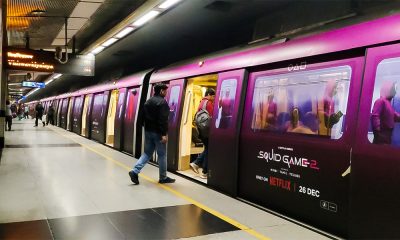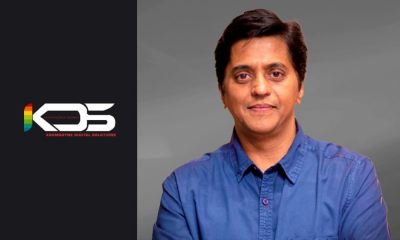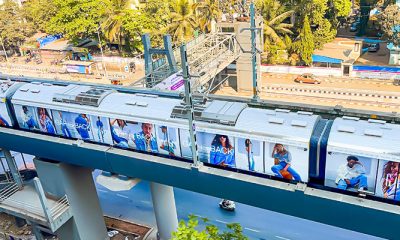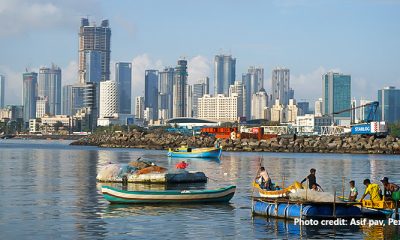Industry News
Long-term capital gains: An outlook on Delhi NCR OOH market
Pray Jani captures the key assertions of leading OOH media operators in the Delhi NCR market.
It has been an exciting year for the OOH stakeholders in Delhi NCR region, with a heavy influx of investment and ad campaigns shining a ray of hope. Media owners are positive that the revenue will see a substantial spike, with possibilities of exceeding the pre-Covid era. While this is a promising claim, that is not all! As the businesses recover in the post-Covid era, Delhi’s OOH witnesses a significant transition that could reshape the media operations.
One of the prominent steps taken during the earlier year was to unify the three municipal corporations of Delhi. The North, South and East corporations became one (Municipal Corporation of Delhi) after about a decade of being divided. The unification was announced to tackle the problems of uneven distribution of resources and overcome the financial challenges that the division caused. But what does that mean for the OOH industry? The unification allows ease of operations, and the OOH stakeholders are pleased with a single body to address for all-things-Delhi.
This year saw India take up the Presidency of G20, which has vastly contributed to the rise in OOH investments. New players, new billboards, and numerous tenders have come in during this year to boost the state of the industry. The municipal corporation has urged the media owners to invest in the modification of the media assets, turning them into attractive destinations for brands.
The post-Covid phase has seen many new brand categories making an appearance on outdoor advertising formats. Although OTT is one of the most prominent categories in recent times, Delhi has seen the number of regional businesses on OOH grow significantly. This has been due to the reduced costs of the media due to the pandemic. A large number of regional businesses are exploring the OOH industry’s impact on their business. The traditional clientele of OOH has seen some shifts, with PSUs reducing their spends on marketing and advertising. However, top ad spenders have remained consistent, which is a major positive for the industry.
Delhi NCR’s most prominent OOH channel is the transit media. The efficient Delhi Metro network is well-positioned in the lifestyle of the Delhi NCR population. Hence, it did not come as a surprise that it was the first to be hit during the pandemic. However, media owners have now begun to invest in metro media and metro branding infrastructure, which suggests that the industry is finally recovering. Tenders for semi-naming rights have been published in the recent months which has turned the competition into motion. Popular brands remain a big part of metro advertising as the Delhi Metro Rail Corporation (DMCR) continues to offer attractive propositions for metro branding. DOOH media on the rail network, for instance, makes it all the more attractive for brands and agencies alike.
The DOOH ecosystem is spreading fast! The post-covid era’s digitisation of OOH starting from Mumbai and Ahmedabad has now come to Delhi, with media owners looking to expand their offerings through the installation of innovative DOOH formats. The unique targeting prospects of DOOH has attracted the attention of many heads from agencies and brands alike. With the metro network and DOOH media coming together, media owners believe there are countless growth possibilities that can be explored.
However, the city’s buzzing OOH scenario doesn’t come without its challenges. Being the capital, the municipal corporation has a responsibility towards maintaining the beauty of the city’s skyline. This has led to size 
 restrictions on the large format OOH assets. Although media owners are pushing to increase the sizes of their OOH formats, the current state of affairs will not allow a size larger than 20ftx10ft, with a few areas allowed up to 26ftx13ft size unipoles. Additionally, the tender costs have been five times the value of the industry standards, and the media owners are discussing with the MCD to bring these costs down and allow room for investment opportunities.
restrictions on the large format OOH assets. Although media owners are pushing to increase the sizes of their OOH formats, the current state of affairs will not allow a size larger than 20ftx10ft, with a few areas allowed up to 26ftx13ft size unipoles. Additionally, the tender costs have been five times the value of the industry standards, and the media owners are discussing with the MCD to bring these costs down and allow room for investment opportunities.
The industry stakeholders believe that there is ample room for growth, and they are playing an active role as investors to rebuild the industry as a whole. Alongside metro media, the stakeholders are now looking at the DOOH space for an opportunity to invest. Speaking about their investment, Shailender Luthra, MD and CEO, Unison Advertising, says, “In recent years, we have been investing in MCD tenders and mall tenders. However, our focus now is to venture into the DOOH space. MCD has opened Delhi to allow DOOH assets and our strategy would be to expand our DOOH network since the brands too are keen on advertising on the digital media.” It has been observed that the inclination towards DOOH stems from the demand from brands wanting to shift towards the data-driven DOOH network.
“We are constructing a network of 30 digital displays, which would be India’s first digital network of such a large proportion. We are very excited about this new addition to our portfolio and we are leaving no stone unturned to make it a big success,” added Jay Samal, Director, Media 24×7 Advertising. He said that the advent of the digital OOH media network has allowed brands to create engaging campaigns and drive higher attention among the consumers. Transit media giants, Sapphire Media Limited have also added 500 digital screens on Line 7 and 170 screens on Line 8 of the Delhi Metro, and have also installed 5 large format 12×8 screens on high footfall stations.

 Praveen Gupta, MD, eg. Communications shares that they have taken steps to expand their metro brand proposition when they acquired the tender for the Metro lines 3 and 4. “We are currently looking to install about 150 LED screens across our newly acquired metro lines and observe how they perform in the digital-first OOH ecosystem. In the long run, we hope to add more screens to our DOOH network,” he commented.
Praveen Gupta, MD, eg. Communications shares that they have taken steps to expand their metro brand proposition when they acquired the tender for the Metro lines 3 and 4. “We are currently looking to install about 150 LED screens across our newly acquired metro lines and observe how they perform in the digital-first OOH ecosystem. In the long run, we hope to add more screens to our DOOH network,” he commented.
The Delhi NCR market has observed a significant rise in business owing to many factors. The MCD has released about 2 to 3 tenders per month in recent times, for multiple formats and regions. This has vastly contributed towards increasing the investment opportunities in the Delhi NCR market. Ritesh Vasudeva, CEO, Hindustan Publicity states, “The unification of the three municipal corporation has helped the state of OOH business in Delhi. The tender influx has led to a number of new media pouring in which provides multiple advertising options for brands and contributes to the revenue of the municipal corporation.” Although the tenders have been valued higher than the market rate, which may have hindered the entry of new players, according to Ritesh, many new players have joined the OOH media owning business. This simply points to the confidence that businesses have in Delhi NCR’s outdoor capabilities.
 Adding to this, Sahil Mangla, Founder & Director, Sapphire Media comments, “Delhi-NCR is quickly emerging as the hub of the advertising world in India. One of the reasons for this shift is that big ad spenders like Maruti, Pepsi, Coke, Nestle and more, are based in Delhi-NCR. Consequently, the ad industry has grown too.” The numerous tenders that have been passed may have increased the number of sites, but that may not be an accurate indication towards the growth of the industry.
Adding to this, Sahil Mangla, Founder & Director, Sapphire Media comments, “Delhi-NCR is quickly emerging as the hub of the advertising world in India. One of the reasons for this shift is that big ad spenders like Maruti, Pepsi, Coke, Nestle and more, are based in Delhi-NCR. Consequently, the ad industry has grown too.” The numerous tenders that have been passed may have increased the number of sites, but that may not be an accurate indication towards the growth of the industry.
Shailendra says, “The recent months have seen many new media get erected in Delhi’s OOH space. This is a positive, but the growth must be backed by the spends. However, the media asset growth has happened only recently and we are optimistic that it will be backed by brands spending actively on the newer media assets.” When discussing about the brand engagement within the Delhi region, other media owners have experienced positive trends.
According to Jay, “Brand engagement in OOH advertising has increased significantly in Delhi NCR, with numerous categories utilising this medium to successfully reach their target audience. Although I do not have data for the whole of Delhi NCR market, real estate accounts for about 40% of OOH revenue in Ghaziabad, with education, FMCG, and organised retail also contributing significantly. We can also notice a strong trend of rising marketing spending in the quick-commerce and electric vehicle sectors.”
DMRC has always been big on OOH advertising. They have remained in sync with the popular OOH trends and allowed media owners to implement these changes across the metro network. On the other hand, up until recently, the three municipal corporations had varying views on matters pertaining to OOH. This created discrepancies among the OOH industry within Delhi NCR. With the unification, the stand of the municipal is undergoing a shift. Discussing about the OOH regulatory environment, Sahil says, “OOH regulatory environment is positive for us because we deal with DMRC. They are supportive towards the media owners. The body is very organised, and they update themselves from time to time.” On the other hand, the MCD has maintained a size cap on traditional hoardings across the city. The 20ftx10ft media formats raise concerns for the brands about their expenditure on OOH within the Delhi NCR.
 Dinesh Vasudeva, Director, Pioneer Publicity states, “The regulatory bodies must allow the expansion of outdoor media assets. In comparison to the 40ftx20ft sites in Mumbai, the sites in Delhi are not as readily opted for by the brands. With an investment like Rs 10 lakh, brands today expect a larger screen size. It would be beneficial for the industry as well as the government if the corporation could allow larger sizes in areas with room to accommodate them. Additionally, Jay points out the current OOH laws are governed by the Municipal Corporation Act of 1959, when billboards were hand-painted. With the digital billboards and vast technological opportunities in OOH, one cannot view the industry the same way it was back in 1959.
Dinesh Vasudeva, Director, Pioneer Publicity states, “The regulatory bodies must allow the expansion of outdoor media assets. In comparison to the 40ftx20ft sites in Mumbai, the sites in Delhi are not as readily opted for by the brands. With an investment like Rs 10 lakh, brands today expect a larger screen size. It would be beneficial for the industry as well as the government if the corporation could allow larger sizes in areas with room to accommodate them. Additionally, Jay points out the current OOH laws are governed by the Municipal Corporation Act of 1959, when billboards were hand-painted. With the digital billboards and vast technological opportunities in OOH, one cannot view the industry the same way it was back in 1959.
In matter of DOOH, Jay suggests, “Authorities must recognise technology-enabled media formats such as DOOH and enact regulations based on an awareness of their complexities. Additionally, operators should be allowed longer operating tenures to encourage them to make larger capital investments in contemporary infrastructure building.”
He goes on to recommend a few additional changes to the OOH policies in Delhi NCR that need to be implemented. In a larger sense, Shailendra points out that the challenge that OOH industry as a whole faces is the lack of a uniform policy across the states. “When we have so many conditions for each city and state, it provides an unfair advantage to one over the others. Moreover, it confuses the clients. They are compelled to get used to the laws of each city. In my opinion, it should be uniform across the metro cities of the country,” he commented.
It is certain that Delhi NCR offers many positives to the brands. The well-structured transit media network is by far the most unique and desired proposition that Delhi NCR has to offer. Moreover, the unification of the three municipal bodies has been welcomed by the OOH stakeholders. It has streamlined many of the industry’s operations as it is likely to create more focused policies. The corresponding consequence of this unification has led to multiple tenders being rolled, which has potentially increased the OOH assets by about 30%. According to Praveen, this is going to hamper the demand-supply balance. However, the media owners are positive that in the coming months, many sectors will launch OOH campaigns, with even start-ups considering to step into the OOH space in coming months. With the number of campaigns on the rise, the recovery of various sectors is already seen within Delhi NCR’s OOH industry. With agency bringing about 50% of the OOH business, Delhi NCR’s regional businesses are gradually increasing their footing on OOH media.
Metro media continues to remain the most desired and competitive space and with DMRC allowing digital OOH assets, brands are expected to continue their position across the metro rail network. The traditional media owners are displeased by the corporation’s cap on media size and are pushing to increase it in specific areas. Besides this, media owners are happy with the corporation’s favourability towards digital screens in the outdoor spaces. Going forward, brands and agencies will likely keep a close eye on the development and standards of the DOOH network in Delhi NCR.
-

 Campaigns
CampaignsNetflix India goes full green light on OOH with Squid Game season 2
-

 Creative Concepts
Creative ConceptsSkechers launches 3D cricket shoe Bus Shelters in Mumbai
-

 Sustainability
SustainabilityStatus of sustainable printing in the OOH Industry: Challenges and pathways forward
-

 Sustainability
SustainabilityGreen Advertising: Insights on Sustainability in Out-of-Home Campaigns
























